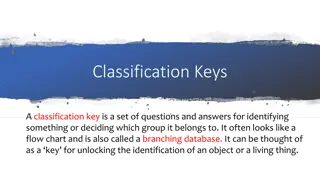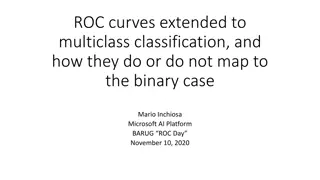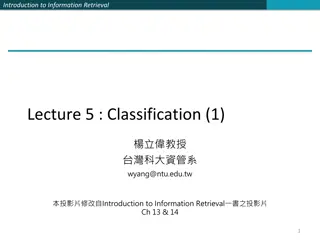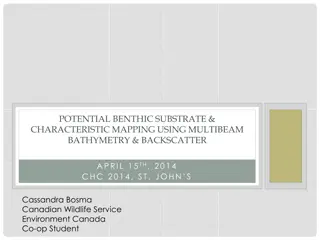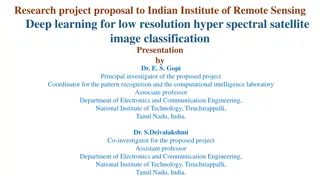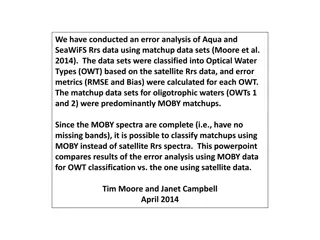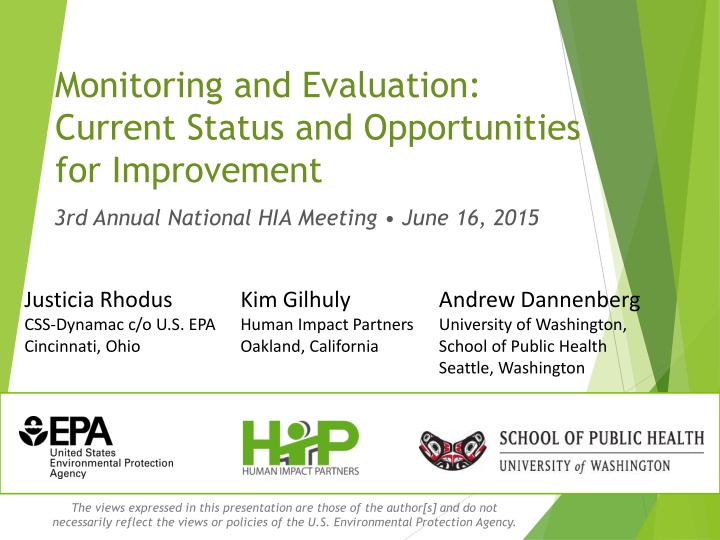
Case Study of Classification with Educational Data
This case study delves into detecting SMART model cognitive operations in mathematical problem-solving processes, aiming to build detectors for inferring behaviors associated with self-regulation. The research goal is to embed interventions that provide recommendations to students and reports for teachers on effective strategies. Automated detectors of SRL constructs were built from a theory-driven lens, focusing on algorithmic bias and model performance.
Download Presentation

Please find below an Image/Link to download the presentation.
The content on the website is provided AS IS for your information and personal use only. It may not be sold, licensed, or shared on other websites without obtaining consent from the author. If you encounter any issues during the download, it is possible that the publisher has removed the file from their server.
You are allowed to download the files provided on this website for personal or commercial use, subject to the condition that they are used lawfully. All files are the property of their respective owners.
The content on the website is provided AS IS for your information and personal use only. It may not be sold, licensed, or shared on other websites without obtaining consent from the author.
E N D
Presentation Transcript
Monitoring and Evaluation: Current Status and Opportunities for Improvement 3rd Annual National HIA Meeting June 16, 2015 Justicia Rhodus CSS-Dynamac c/o U.S. EPA Cincinnati, Ohio Kim Gilhuly Human Impact Partners Oakland, California Andrew Dannenberg University of Washington, School of Public Health Seattle, Washington The views expressed in this presentation are those of the author[s] and do not necessarily reflect the views or policies of the U.S. Environmental Protection Agency.
The HIA Process Screening Scoping Assessment Recommendations Reporting Monitoring & Evaluation 2 2
Monitoring and Evaluation Objectives Monitoring To monitor or track the data necessary to inform HIA evaluation Evaluation To evaluate: 1) the process of conducting the HIA 2) impacts on the decision-making process and implementation of the decision 3) impacts of the decision on health outcomes 3
Types of Evaluation in HIA PROCESS EVALUATION evaluates whether the HIA was carried out as planned and in accordance with applicable standards It typically looks at: successes and challenges effectiveness in meeting HIA goals lessons learned who was involved strengths and weaknesses effectiveness in meeting practice standards 4
Types of Evaluation in HIA IMPACT EVALUATION evaluates the impacts of the HIA on the decision and decision- making process, as well as the decision-making climate, in general It typically looks at: Recommendations adoption Discussion of HIA findings in decision-making Decision implementation Capacity and collaboration building How awareness and consideration of health changed in the decision- making climate as a result of HIA How HIA institutionalization changed as a result of HIA 5
Types of Evaluation in HIA OUTCOME EVALUATION evaluates the impact of the decision implementation on health It typically looks at: Impact on health status Impact on health determinants Impact on health behavior Early warning signs of unexpected consequences Validity and precision of health impact predictions And requires: On-going monitoring of health data 6
Monitoring & Evaluation Timeline HIA Process Evaluation HIA Impact Evaluation Final decision informed by HIA HIA Outcome Evaluation Monitoring Evaluation of the HIA process, impacts, and outcomes is necessary for field development and practice improvement. 7
Monitoring and Evaluation Plan: An HIA Minimum Element HIA proposes indicators, actions, and responsible parties, where indicated, for a plan to monitor the implementation of recommendations, as well as health effects and outcomes of the proposal. The Minimum Elements and Practice Standards also provide guidelines (practice standards) for monitoring and evaluation. 8
Status of Monitoring and Evaluation in HIA In practice, most HIAs do not include process, impact, or outcome evaluation; this has been attributed to a lack of interest, time, and resources in the case of process and impact evaluation and to the length of time (often many years) required for observing changes related to implementation. National Research Council 2011 Monitoring is one of the least well developed of all the phases of HIA practice. Ross, Orenstein, & Botchwey 2014 9
Status of Monitoring and Evaluation in HIA Just over half (13/23) of HIA reports described intentions, plans, or results of monitoring and evaluation. Schuchter, Bhatia, Corburn, & Seto 2014 All three forms of evaluation were lacking in the (81) reviewed HIAs Proposed plans for impact and/or outcome evaluation were present in only 29 of the HIAs. EPA Review 2013 10
Benefits of Monitoring and Evaluation Holds partners and agencies accountable Tests the validity and precision of health impact predictions made in Assessment http://ts3.mm.bing.net/th?id=HN.608010371159755730w=162h=145c=7rs=1url=http%3a%2f%2fwww.anistyping.ie%2fThe_Benefits_to_You.htmlpid=1.7 Adds to the body of knowledge/ evidence base Provides early warning of unforeseen results/impacts Empowers communities when they are involved in monitoring 11
Benefits of Monitoring and Evaluation Provides a way to circle back to the community and stakeholders Provides a better understanding of the value of HIA (inform decision-making and protect and promote health) http://ts3.mm.bing.net/th?id=HN.608010371159755730w=162h=145c=7rs=1url=http%3a%2f%2fwww.anistyping.ie%2fThe_Benefits_to_You.htmlpid=1.7 Lessons learned to improve the HIA process and field overall Supports future HIAs and Health in All Policies Strengthens the HIA profile in public health and other fields 12
Challenges of Monitoring and Evaluation Difficult to measure impact on health outcomes Challenging due to the long time horizons for change Many causal relationships with health outcomes Difficult to determine what impact the HIA itself had on a health outcome Difficult to differentiate whether the outcome is due to the impact of the decision or HIA recommendations 13
Challenges of Monitoring and Evaluation Lack of funding/resources Lack of planning/time allocated Responsibility for implementation (especially long-term monitoring) External (political/organizational) resistance, pushback, or unrealistic expectations Selection of indicators choose wisely Lack of implementation/ documentation in HIA (few to no good examples) 14
Examples of Monitoring and Evaluation in HIA Planning and Implementation 2010 Hawai i County Agriculture Development Plan Health Impact Assessment Healthy Corridor for All St Paul Transit Oriented Development HIA Eastside Greenway Health Impact Assessment: Protecting Health and Equity in All Policies 15
Hawaii Agriculture Development Plan HIA Assessed three policies: Increased institutional purchase of locally grown food Commercial expansion of locally grown food Promotion of home, community, and school gardening 16
Hawaii Agriculture Development Plan HIA Monitoring Plan Link Indicators to Recommendations Identified indicators to be monitored, agency responsible for monitoring, and timing for recommendations in each of the three policies assessed Recommendations were very thoughtful, specific, and extensively vetted among stakeholders Monitoring Plan was, at the time, created with no input; developed simply as an HIA requirement 17
Hawaii Agriculture Development Plan HIA Monitoring Plan HIA Recommendations Convene a working group to facilitate Farm to School under the auspice of the Agricultural Advisory Commission State legislature should modify Act 175 SHL 2009 and/or procedures to remove barriers to local produce procurement by Dept. of Educ. and state agencies Dept. of Educ. School Food Authorities should utilize funds under USDA s FFVP to purchase local produce Dept. of Educ. School Food Service Branch, together with culinary experts, should revise school lunch and breakfast menus to incorporate locally produced foods 18
Hawaii Agriculture Development Plan HIA Challenges in Monitoring Data hard to come by (State Agriculture Committee positions defunded due to budget) Lack of funding for monitoring Timelines in monitoring plan were not accurate Successes in Monitoring Kohala Center has a vested interest in recommendation implementation, so they are slowly chipping away at the monitoring plan. Kohala Center got USDA grants to increase local food production and purchase; using some to help fund monitoring 19
Hawaii Agriculture Development Plan HIA Lessons Learned in Monitoring Identify who will implement recommendations and work with them (as the responsible parties for monitoring) to develop the Monitoring Plan to ensure feasibility Identify a lead organization to track and report results Even when an agency/org tracks the data as part of its job, someone must be responsible for gathering all tracked indicators together In most cases, unrealistic to expect HIA practitioners to monitor; must be an agency/ org with a vested interest in implementation 20
Healthy Corridors for All St Paul Transit HIA Examined rezoning proposal along the St. Paul portion of the Central Corridor Light Rail Transit Line Three priorities: Healthy economy, Affordable healthy housing, Safe and sustainable transport 50 indicators selected for the research plan/examined in Assessment Measurable, available, able to answer research question, relevant, adequate time and resources 21
Healthy Corridors for All St Paul Transit HIA Monitoring Plan Link Assessment to Monitoring and Evaluation To monitor the impact of rezoning, a subset of the 50 indicators used in Assessment (n=13) were selected for data collection at 5-year intervals Targeted the highest priority objective for Community Steering Committee: Protecting against the negative impacts of gentrification Identified indicators to be monitored, monitoring questions, and organization responsible for collecting data 22
Healthy Corridors for All St Paul Transit HIA Monitoring Plan 23
Eastside Greenway HIA Assessed creation of a multi-use path Connected some existing trails + created new ones Would result in ~ 30 mile stretch of trail Runs through 17 municipalities Municipalities very different: SES, race Focus on equity in implementation Cuyahoga County, Ohio (Cleveland, Ohio and suburbs) 24
Eastside Greenway HIA Monitoring Plan Use Health Determinants and Health Behaviors as Indicators of Health Impact A Tale of One Indicator: Usage Vital tie from health determinants (is trail constructed and connected?) to health outcomes (physical activity) No data available in Assessment Cuyahoga County Board of Health (CCBH) was able to leverage other funding to dedicate to collecting baseline and monitoring usage data 25
Eastside Greenway HIA A Tale of One Indicator: Usage Funding from various parties with a vested interest in tracking usage of trail Transportation for Livable Communities Initiative (TLCI) through Metropolitan Planning Organization Metroparks CCBH Healthy Communities funding Funding leveraged in part because this indicator was part of the official HIA Monitoring Plan 26
Improving Implementation of Monitoring and Evaluation Best Practices Essential Elements of a Monitoring and Evaluation Plan SOPHIA Working Group convened at the 2014 HIA of the Americas Workshop for improving the practice of monitoring and evaluation in HIA 27
Best Practices in Monitoring and Evaluation Think of monitoring and evaluation early in the HIA process Bring the right people to the table to put together and vet the monitoring and evaluation plan Those with critical data Decision-makers Stakeholders/those affected Those with technical knowledge/experts Client or proponent for whom you are doing the project Those who will implement it 28
Best Practices in Monitoring and Evaluation Consider/seek funding for monitoring and evaluation Engage stakeholders and the community Include in the HIA Report, or at a minimum acknowledge, plans for impact and outcome evaluation If impact and/or outcome evaluation is infeasible, the HIA should discuss the limitation(s) preventing monitoring and evaluation 29
Best Practices in Monitoring and Evaluation Identify indicators that can be used in assessment and monitoring and evaluation When possible, include data that are routinely collected and available over time Link indicators to recommendations Use health determinants and health behaviors as indicators for health impact 30
Best Practices in Monitoring and Evaluation Identifying an action or notification if monitoring indicates a negative impact or is trending to negative Include recommendations for/prioritize monitoring and evaluation efforts Communicate limitations, strengths, and value of monitoring and evaluation Report results of monitoring and evaluation 31
Best Practices in Monitoring and Evaluation Think of Monitoring and Evaluation Early During Scoping, consider how to build process evaluation into the HIA process During Scoping and Assessment, look for potential data, approaches, indicators, metrics, and performance measures that could be used in both assessment and monitoring and evaluation 32
Best Practices in Monitoring and Evaluation Seek Opportunities to Fund Creatively Consider/seek funding for monitoring and evaluation Parse out portion of your HIA grant/funding for monitoring Use other funding sources creatively Seek grants for monitoring, knowing that it will help implementation Ensure other community organizations get funding for their part in monitoring 33
Best Practices in Monitoring and Evaluation Link Assessment with Monitoring and Evaluation Indicators, metrics, and performance measures in the health, social, environment, and economic sectors provide an opportunity to link the HIA assessment with a post-decision monitoring plan 34
Best Practices in Monitoring and Evaluation Use Health Determinants and Health Behaviors as Indicators of Health Impacts Indicators can include: Health status Health behaviors Health determinants 35
Best Practices in Monitoring and Evaluation Engage Stakeholders and the Community Meaningfully include stakeholders in planning monitoring and evaluation Some of the inherent challenges in monitoring and evaluation can be addressed by leveraging resources and using stakeholders and the community in conducting monitoring and evaluation 36
Essential Elements of a Monitoring and Evaluation Plan Goals of monitoring and evaluation Resources and responsible actor(s) Questions/outcomes to be addressed Indicators for monitoring SMART - Specific, Measurable, Attainable, Realistic, Timely Tied to HIA Recommendations Based on a common set of relationship factors/indicators related to the field Qualitative reporting/measures (squishy indicators) 37
Essential Elements of a Monitoring and Evaluation Plan Frequency/duration of monitoring and reporting out Monitoring/data collection methods Triggers or thresholds that may lead to review and adaptation in decision implementation Plans for communication, reporting, and dissemination of results 38
Monitoring and Evaluation Large Group Exercise What Would Monitoring and Evaluation Look Like? 39
Monitoring and Evaluation Large Group Exercise Using the Recommendations listed on following slide: A. Suggest indicators for monitoring and who could be the responsible agency or organization B. Discuss the value of tracking this data in implementation C. How would you report out the results of monitoring to ensure transparency, accountability, and that adjustments are made along the way of implementation? 40
Monitoring and Evaluation Large Group Exercise Tuition Assistance Program (TAP) HIA Recommendations 1. NY legislature should restore TAP funding for qualified incarcerated people 2. Department of Corrections (DOC) should provide space, security, technology and other resources to ensure successful college programs 3. DOC should allow and honor educational holds to limit transfers of students to different prisons 4. College providers should meet rigorous academic standards 41
Wrap Up and Charge It is our that you leave this session with a better understanding of how to plan for and implement monitoring and evaluation in HIA Justicia Rhodus CSS-Dynamac c/o US EPA rhodus.justicia@epa.gov Kim Gilhuly Human Impact Partners kim@humanimpact.org Andrew Dannenberg University of Washington School of Public Health adannen@uw.edu 42

